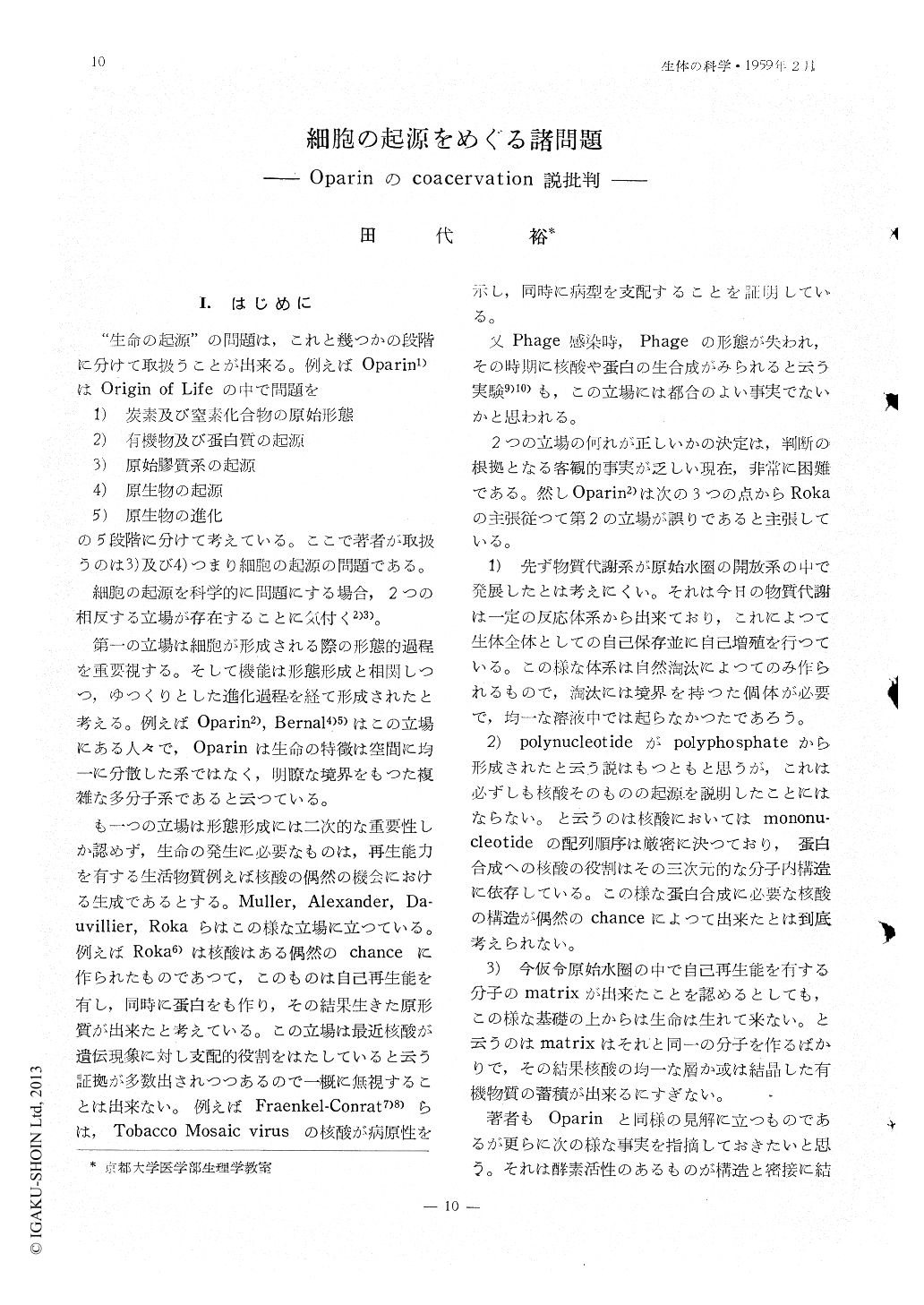- 有料閲覧
- 文献概要
- 1ページ目
I.はじめに
"生命の起源"の問題は,これと幾つかの段階に分けて取扱うことが出来る。例えばOparin1)はOrigin of Lifeの中で問題を
1)炭素及び窒素化合物の原始形態
2)有機物及び蛋白質の起源
3)原始膠質系の起源
4)原生物の起源
5)原生物の進化
の5段階に分けて考えている。ここで著者が取扱うのは3)及び4)つまり細胞の起源の問題である。
細胞の起源を科学的に問題にする場合,2つの相反する立場が存在することに気付く2)3)。
In 1938, Oparin1) has published his "Origin of Life", in which he proposed a hypothesis that the intermediary steps from organic substance to cell is coacervation, in especial com-plex coacervation. This assumption appears to be very probable, because complex coacer-vate has a number of similarities with cell or cell constituents, as have been pointed out by Bungenberg de Jong et al17)18).
Recent electromicroscopical, cytochemical and physicochemical studies on cell or cell con-stituents, however, do not always agree with his assmption24)-28). These studies have sho-wn that the structural elements of cell, such as the microsomes, tne membranes of mito-chondria, nuclear and cell membrane are all composed of a double membrane. This mem-brane is probably composed of a double leaflet of lipids sandwiched by two protein layers (Figs. 1 and 2) and may be created from the lipoprotein molecules by the association and rearrangement of them.
It seems to the author, therefore, that the intermediary steps from organic molecule to cell is not the (complex) coacervation, but a micelle formation by surface active molecules such as lipide and the adsorption of protein or polypeptides on to the surface of the micelle (Fig. 3). The adsorption of protein has a stabilizing effect on the micelle by lowering the surface tension. The micelle structure constructed in such a manner is probably more sta-ble than the coacervate, and more suitable for the intermediary steps in the origin of life.
From the colloid chemical point of view, lipide micelle is different from the coacervation, because, 1) the diameter of the fundamental unit of lipide or lipoprotein micelle is usually less than 100 A and it is, in itself, in a true colloidal state, and not in a state of coacervate (It is possible, however, to obtain a coacervate of the lipide or lipoprotein micelle)
2) the mechanisms for the formation of the micelle are quite different from that for the formation of the coacervate. Van der Waals force between hydrophobic carbon chains is mainly responsible for the formation of the former, while ionic attraction between opposi-tely charged macromolecules and dehydration are responsible for the formation of the la-tter.
On the International Symposia on Enzyme Chemistry in Tokyo (1957), Prof. A. I. Oparin23)answered to my discussion and said (1) that it was. impossible to obtain microsomes or mi-tochondria from a homogeneous solution of organic Substances, and in order to obtain them, an already developed complex organism should be used, and (2) that the coacervation was the most effective method to concentrate macromolecular compounds from dilute solutions, and (3) that the lipoid accumulation cannot be distinguished from the occurrence of the coace-rvate.
I should like to answer to his opposite opinion.
1) It is true that to obtain microsomes or mitochondria from a homogeneous solution is impossible without an already developed complex organism, but the micelle formation of lipide is a physicochemical process as is coacervation, and is possible without any help of complex organism.
Moreover, the auther is in opinion that protein is rather differentlated and developed on the surface of the lipoid micelle23).
2) Not only the coacervation, but also lipide micelle is very effective method to concen-trate macromolecules from dilute solution. For example, any lipoid surface in contact with a protein solution, even if as dilute as one part in 107 or more, is reported to be co-vered with protein by Danielli29).
3) An answer to the third question has been related above.

Copyright © 1959, THE ICHIRO KANEHARA FOUNDATION. All rights reserved.


